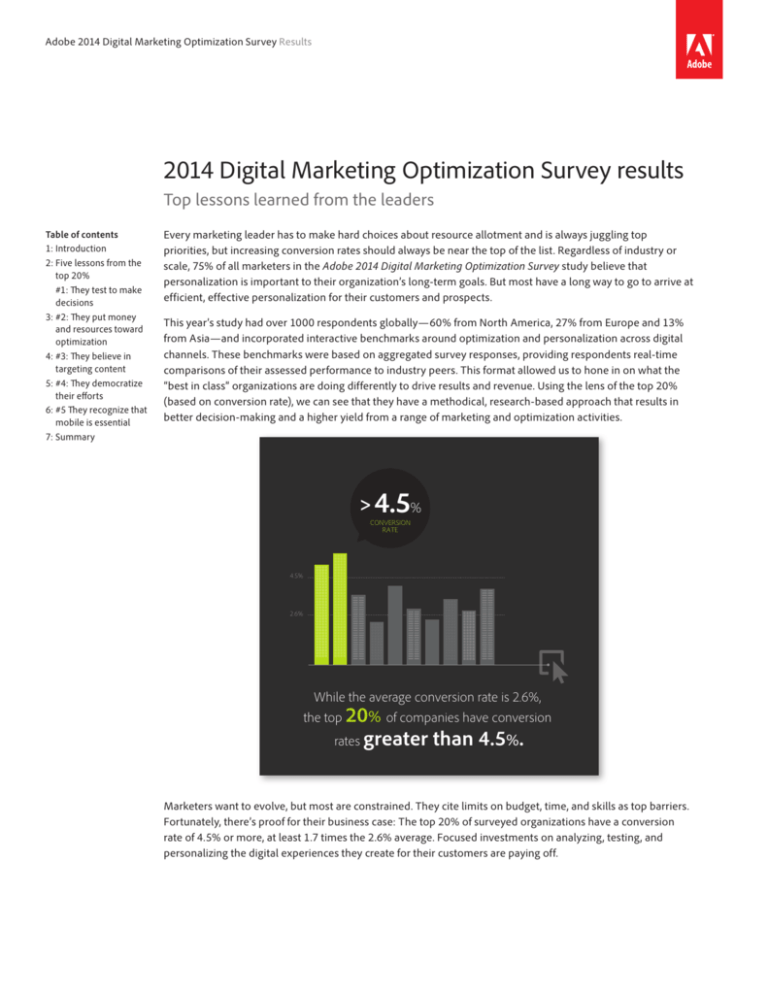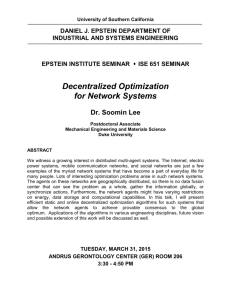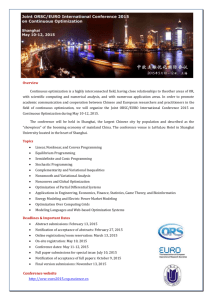
Adobe 2014 Digital Marketing Optimization Survey Results
2014 Digital Marketing Optimization Survey results
Top lessons learned from the leaders
Table of contents
1:Introduction
2:Five lessons from the
top 20%
#1: They test to make
decisions
3:#2: They put money
and resources toward
optimization
4:#3: They believe in
targeting content
5:#4: They democratize
their efforts
6:#5 They recognize that
mobile is essential
7:Summary
Every marketing leader has to make hard choices about resource allotment and is always juggling top
priorities, but increasing conversion rates should always be near the top of the list. Regardless of industry or
scale, 75% of all marketers in the Adobe 2014 Digital Marketing Optimization Survey study believe that
personalization is important to their organization’s long-term goals. But most have a long way to go to arrive at
efficient, effective personalization for their customers and prospects.
This year’s study had over 1000 respondents globally—60% from North America, 27% from Europe and 13%
from Asia—and incorporated interactive benchmarks around optimization and personalization across digital
channels. These benchmarks were based on aggregated survey responses, providing respondents real-time
comparisons of their assessed performance to industry peers. This format allowed us to hone in on what the
“best in class” organizations are doing differently to drive results and revenue. Using the lens of the top 20%
(based on conversion rate), we can see that they have a methodical, research-based approach that results in
better decision-making and a higher yield from a range of marketing and optimization activities.
> 4.5%
CONVERSION
RATE
4.5%
2.6%
While the average conversion rate is 2.6%,
the top 20% of companies have conversion
rates greater
than 4.5%.
Marketers want to evolve, but most are constrained. They cite limits on budget, time, and skills as top barriers.
Fortunately, there’s proof for their business case: The top 20% of surveyed organizations have a conversion
rate of 4.5% or more, at least 1.7 times the 2.6% average. Focused investments on analyzing, testing, and
personalizing the digital experiences they create for their customers are paying off.
Five lessons from the top 20%
#1: They test to make decisions
The top performers use testing to aid in decision-making, whether at an individual, team, or corporate level.
Data and performance metrics are consistently used to analyze test results, evaluate the tactics used, and
recommend next best actions.
70% of top performers use testing in various capacities, compared to only 46% for the rest of the sample.
Figure 1. What statement best describes your organization’s current approach to testing?
54%
30%
19%
18%
11%
My company has
adopted testing
as a form of
decision-making
17%
12%
My team has
adopted testing
as a form of
decision-making
16%
12%
I have adopted
testing
as a form of
decision-making
Top 20%
11%
The marketing Testing is not a priority
department has
in my company yet
adopted testing
as a form of
decision-making
Bottom 80%
The power of this approach doesn’t end with A/B splits on campaign variables and incremental conversion rate
optimization. There’s no better tool than an experiment to cut through red tape or help leap a silo, because
good data and analysis isn’t biased or political.
Leaning on optimization to make decisions can be a cultural challenge in an organization, but one that is easy
to gain the support for using these recommendations:
• Make sure that your data is clean, consistent, and trusted within the organization.
• Use data to identify where you should focus your optimization efforts to prioritize your optimization roadmap and construct alternative test concepts.
• Define your main optimization conversion event for your program and how you will use it to calculate ROI.
Ensure that it aligns to your organization’s key performance indicators and incentives.
• Invite executive and stakeholder sign-off on this main conversion event to help communicate that your
program efforts will help them reach their goals.
• Provide high-level data points and key insights to explain your optimization actions and wins with your team
and across your organization.
The survey results show that companies who shift to a culture that embraces optimization to make decisions
increase conversion 100%.
Adobe 2014 Digital Marketing Optimization Survey Results
2
100%
CONVERSION
5%
SPENT ON
OPTIMIZATION
Top-converting companies spend
more than 5% of their budgets
on optimization.
Companies with a culture of optimization had
a conversion rate that was 100%
higher.
#2: They put money and resources toward optimization
As decision-making moves from instinct to math, budgeting for optimization gets easier. Top performers are
54% more likely to be devoting more than 5% of their budgets to a variety of optimization activities. In
comparison, 44% of respondents spend less than 5% of marketing budget on optimization.
Figure 2. What percentage of your total marketing budget is allocated to
optimization activities (including agency fees, professional services, technology)?
44%
31%
28%
20%
17%
16%
10%
10%
5%
Less than 5%
6%–10%
11%–15%
Top 20%
4%
16%–25%
9%
5%
26% and above
Don't know
Bottom 80%
The digital landscape has continued to evolve and innovate, but there has been little change in investment
necessary to make marketing really count. Prioritizing optimization within an organization can make a huge
impact to the top- and bottom-line revenues. The top 20% are 50% more likely to prioritize testing and benefit
from nearly doubling conversion rate to 3.6% compared to those who do not. Only 34% of the companies
surveyed prioritize testing.
Adobe 2014 Digital Marketing Optimization Survey Results
3
It’s a cyclical process: More budget toward optimization efforts yields higher conversion rates and revenue to
then fund into additional activities. Start with small wins to demonstrate the proof points and gain momentum
for larger investments.
Figure 3. Which customer experience measurement and optimization tactics do you currently use?
Website analytics
Social media analytics
Social sharing
(social sharing icons on pages)
Email optimization
Customer reviews
Mobile analytics
A/B testing
Onsite search
Profile targeting
(e.g. geography, segments, traffic source)
Retargeting or remarketing
Audience segmentation
Onsite survey
Multivariate testing
Attribution modeling
Automated recommendations
Automated behavioral targeting
Other
Top 20%
Bottom 80%
0%
20%
40%
60%
80%
100%
Overall, the top performers are 46% more likely to be using optimization capabilities. Of special note, they are
far more likely to be segmenting audiences (+111%), using mobile analytics (+90%), and performing A/B testing
(+60%). They understand the link between optimization and higher profit and continue to invest in an
expanded array of activities.
#3: They believe in targeting content
In a recent CMO Survey, 40.5% of CMOs say that their company is using customer behavior data for targeting,
and 88.5% said that the use of such data for targeting was increasing.1 For many companies, content is the new
advertising; in this digital transformation, it’s time to make content relevant to each customer if you aren’t yet.
For the top 20% there is a 43% greater likelihood that they are using various content targeting processes. They
recognize the opportunity to target and personalize content and are working toward it. They are far also more
likely to be using automation and data to make content decisions (+83%). But even for those relying on people
to place content, there are more stakeholders and, therefore, more attention being paid.
Whether targeting a particular audience group or just an audience of one, optimized personalization enables
marketers to enhance the relevance and efficiency of new and repeat visitor experiences. Respondents
targeting more than 20% of visitors achieved two times the average conversion rate at 5%. If you align yourself
to the 76% not targeting at that level, start with a few site sections and continuously refine your targeting
processes to make them more effective and efficient. Look for opportunities to expand your optimization
efforts across the customer journey. Evaluate your site for areas that are good candidates for optimization
tactics, such as automated behavioral targeting and recommendations. The more relevant a consumer
experience, the more engaged the customer is, increasing the likelihood for conversion. As Forrester noted,
companies that are personalizing web experiences and who are also able to quantify the improvement in the
context of online sales or their key website performance metric are seeing, on average, a 19% uplift in sales. 2
CMO Survey August 2013 http://cmosurvey.org/results/survey-results-august-2013/
Forrester CIO/CMO Survey 2013 (The CMO And CIO Must Accelerate on Their Path to Better Collaboration)
1
2
Adobe 2014 Digital Marketing Optimization Survey Results
4
Top-converting companies are 43%
4.3%
more likely to use a variety
of targeting techniques.
CONVERSION
43%
When multiple departments are involved
in optimization, conversion jumps from 2.6 to 4.3%.
#4: They democratize their efforts
Optimization is as much about efficiency as it is about success, and for the top 20%, it’s about efficiency for
success. They are 88% more likely to engage other departments for contributions and expansion of their
testing effort. As a whole, the respondents who use this expanded optimization approach see a lift in
conversion from the average of 2.6% to 4.3%. Explore different organizational structures and how they will
allow for maximum collaboration and democratization of the optimization program while maintaining a center
of excellence and the momentum that comes with it. In an ideal state, optimization activities could live
successfully within each business unit and become integral to the execution of all digital experiences. Aligning
optimization goals and incentives across teams to the overall business objectives provides motivation for
healthy collaboration.
Figure 4. Which customer experience measurement and optimization tactics do you currently use?
64%
44%
18%
15%
11%
10%
Manual test
implementation
and analysis
15%
8%
Vendor managed
Automated
Multiple departments
process
program determines
have input in
significance
testing process
and winner
Top 20%
7%
7%
No process
or don't test
Bottom 80%
Adobe 2014 Digital Marketing Optimization Survey Results
5
Additionally, efficiency for success comes with automation. The top 20% are 36% more likely to leverage an
automated approach to testing and pushing winning experiences. This approach is extremely valuable on prime
digital real estate where various marketing teams may be battling for exposure. As optimization activities
transition from testing to targeting on high-trafficked areas of a site, automated personalization can alleviate the
headache and hassles of duelling priorities. Tailoring experiences for a handful of segments to hundreds of
individuals becomes easy. One thing to keep in mind is that automation is best when marketers have control in
order to keep a pulse on performance in real-time and iterate on the learnings.
Automation increases
the average conversion rate
from 2.6 to 3.6%.
#5 They recognize that mobile is essential
Mobile isn’t just a marketing channel; it’s a platform that is becoming as fundamental to commerce as the
desktop and brick-and-mortar outlet. It’s a vital consideration in the modern, cross-channel approach to
customer communications. Most marketers already recognize this, but top performers are out ahead of the pack,
with 83% describing mobile as important to their 2014 cross-channel marketing, compared with 67% of the rest.
Figure 5. How important is focusing on mobile to support your cross-channel efforts in 2014?
44%
42%
41%
Top 20%
Bottom 80%
34%
33%
19%
14%
7%
Very important
Somewhat important
Not important
9%
Don't know
Adobe 2014 Digital Marketing Optimization Survey Results
6
Every business is aware of their customers’ shift to mobile. Whether selling music sharing to teens or mining equipment
to seasoned executives, marketers see that their content is increasingly being consumed away from the desktop.
Figure 6. About what percent of your traffic is from mobile?
(including smart phone, tablet, app and website)
36%
29%
21%
11%
3%
10% or less
11%–20%
21%–40%
41%–60%
Over 60%
It’s time to ask yourself if you have a mobile strategy. When eConsultancy asked this question in its 2013
Mobile Marketing survey, just over a third of the respondents said yes. It’s a hard task to tackle, especially when
the mobile format dramatically changes the context of optimization and personalization. It’s a small screen,
and there’s so little margin, literally and figuratively. There’s less time, less room, and less inclination to wait or
browse on a mobile device—there is only immediate need. Whether brands can satisfy their mobile audience
depends on the ability to recognize what customers want and deliver it with relevance and speed.
So, where to start?
• Look at the mobile data you have today. Mobile makes up nearly 50% of all retail traffic today, according to
Q1 2013 Global Mobile Maturity Executive Online Survey and Forrester Research interviews. Nearly half of all
companies already see more than 20% of their traffic coming via smartphones and tablets, a trend which will
only accelerate in the near future.
• Determine if your desktop website is mobile friendly. Or perhaps your business can benefit from a mobilespecific version. 50% of respondents to eConsultancy’s survey planned on investing in a tablet-specific website
to serve those users best. Whichever version you have, which areas are primed for experience optimization?
The home page is usually the first goldmine and sets the tone for the mobile journey with a brand.
• To app or not to app—that is the question. Industry research says yes. Recent Adobe Digital Index reports
show mobile consumers spend four times longer with a tablet app and two-and-a-half times longer with a
smartphone app than on the web. According to Gartner, worldwide downloads from app stores will pass the
300 billion mark by 2016. Luckily, app optimization technology is becoming available to assist in tracking app
engagement from purchase and download to usage so that you can monitor how it’s contributing to customer loyalty and revenue. Additionally, align your mobile tactics to app-centric goals.
• Target with the lowest-hanging fruit—location. Every mobile device has the inherent ability to track where
a mobile user is at a given time. The easiest step toward mobile personalization is location-based targeting
via GPS or Wi-Fi tracking, points of interest nearby, and the recent innovation of iBeacons. Present a relevant
offer as the mobile user approaches a prime location for immediate action.
Summary
In this ever-evolving digital landscape that is far from slowing down, optimized personalization is key to
keeping customers engaged and satisfied as they interact with your company and brand. While this is not a
new headline for marketers, industry benchmarks now exist clearly highlighting that investing time, money,
and efforts reap revenue rewards. Using optimization to drive success in your organization may be a challenge
in terms of shifting mind-set and practice, but one that can be overcome.
Adobe Systems Incorporated
345 Park Avenue
San Jose, CA 95110-2704
USA
www.adobe.com
Adobe and the Adobe logo are either registered trademarks or trademarks of Adobe Systems Incorporated in the United States and/or other countries. All other trademarks are
the property of their respective owners.
© 2014 Adobe Systems Incorporated. All rights reserved. Printed in the USA.
5/14





